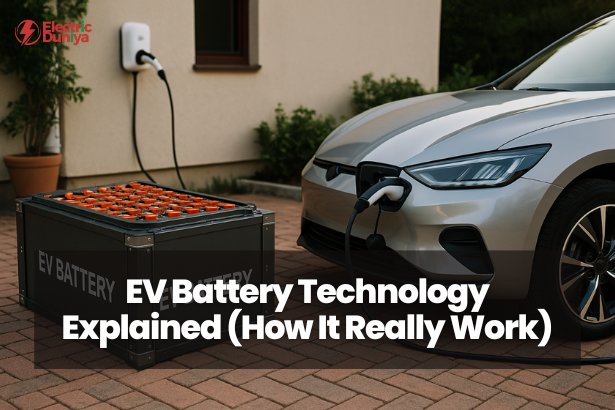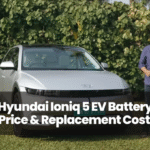When I first drove an electric car years ago, what fascinated me most wasn’t the silence or instant torque — it was the invisible energy source powering it all. Behind every smooth electric drive is a highly engineered EV battery that stores, manages, and delivers power with remarkable precision.
Today, electric vehicle batteries have become the beating heart of modern mobility. These systems define how far an EV can travel, how fast it charges, and how long it lasts.
Over 90% of new EVs rely on lithium-ion batteries, a technology that has evolved from powering laptops to moving entire vehicles. Yet the real story lies deeper — in how these batteries are built, managed, and continually improving through innovation.
What Is an EV Battery and How Does It Work?
At its core, an EV battery is an energy storage system that powers the electric drivetrain of the vehicle. It converts stored chemical energy into electrical energy that drives the motor. Each battery pack module is made up of hundreds or even thousands of individual cells arranged in series and parallel to balance voltage, capacity, and power output.
These cells are grouped into modules, which together form the battery pack — the physical unit you see mounted under the vehicle’s floor. Within this pack lies a Battery Management System (BMS) that constantly monitors temperature, voltage, and current flow. The BMS ensures optimal performance and prevents risks like overcharging or thermal runaway.
During operation, when you accelerate, the battery releases power to the motor; when you brake, it partially recharges through regenerative braking, capturing kinetic energy and feeding it back into storage. This process makes EVs far more efficient than combustion vehicles, converting over 85% of electrical energy into motion.
Most EVs today use lithium-ion batteries due to their high energy density, compact size, and long battery life cycle. These batteries typically operate within a temperature range of 15°C–45°C, managed by a battery cooling system that uses liquid or air-based thermal management for stability and longevity.
What Are the Main Types of Battery Technologies Used in EVs?
Not all EV batteries are the same. The differences in battery chemistry, cost, and performance determine how a car behaves on the road.
Here’s a breakdown of the main types that define the industry today — and the ones shaping its future.
Lithium-Ion Batteries
Lithium-ion technology dominates the EV market because it balances energy density, cost, and reliability. Inside, lithium ions move between the anode and cathode, generating electric current. The most common chemistries include Nickel Manganese Cobalt (NMC), Lithium Iron Phosphate (LFP), and Nickel Cobalt Aluminum (NCA) — each with trade-offs between performance, stability, and price.
Manufacturers like Panasonic, LG Energy Solution, and CATL (Contemporary Amperex Technology Co. Limited) lead in producing these cells for brands such as Tesla, BYD, and Hyundai. Modern lithium-ion EV batteries can last over 1,500 charging cycles, translating to roughly 8–10 years of real-world use.
Their efficiency depends on C-rate (charging speed), Depth of Discharge (DoD), and internal resistance — all parameters that define how fast and safely they can deliver energy. Despite challenges like battery degradation, lithium-ion remains the backbone of electric mobility.
Solid-State Batteries
The future of electric vehicle battery technology lies in solid-state batteries, which replace the liquid electrolyte with a solid material. This shift reduces flammability risks, increases energy density, and improves battery lifespan.
Companies such as QuantumScape and Solid Power are pioneering this technology, aiming for mass adoption by the end of this decade. A solid-state electrolyte also supports fast charging technology with less heat buildup, potentially allowing a 10–80% charge in under 15 minutes.
With higher energy density, vehicles could achieve double the range per charge while maintaining a compact battery weight. However, scalability and production cost remain hurdles before these batteries become mainstream.
Other Emerging Battery Technologies
Beyond lithium-ion and solid-state, researchers are exploring new frontiers. Graphene-enhanced cells offer improved conductivity and reduced self-discharge rate. Sodium-ion batteries, being cheaper and less resource-dependent, are seen as sustainable alternatives, particularly for affordable EVs.
Silicon anode and cobalt-free cathodes are also under development to improve capacity and reduce reliance on rare materials. While still in testing phases, these innovations show that the EV energy storage field is evolving faster than ever.
How Is Battery Capacity Measured and Why Does It Matter?
When people ask why one electric car travels farther than another, the answer almost always comes down to battery capacity. It’s measured in kilowatt-hours (kWh) — a unit that defines how much energy the battery can store. The higher the number, the more electricity the pack holds, and the longer the range per charge.
For context, most electric cars today offer between 40 kWh and 100 kWh of usable capacity. A Tesla Model 3 Long Range, for instance, uses an 82 kWh pack that provides over 500 kilometers of real-world range. But capacity alone doesn’t tell the full story — energy density plays a huge role too.
Energy density measures how much power can be stored per unit of weight. The greater it is, the lighter and more efficient the vehicle becomes. This is why lithium-ion batteries remain the standard — they provide a high power-to-weight ratio, essential for balancing performance, efficiency, and cost.
EV manufacturers constantly work on improving both charging speed (kW) and energy efficiency. Fast-charging networks using DC fast chargers and EVSE (Electric Vehicle Supply Equipment) can replenish 80% of a battery in 20–30 minutes, depending on the chemistry and vehicle system. However, quick charging too often can accelerate battery degradation — a factor we’ll explore next.
What Factors Affect the Life Cycle and Performance of EV Batteries?
Battery longevity is one of the biggest concerns among EV buyers. From my experience testing multiple electric cars, it’s clear that real-world lifespan depends on a mix of chemistry, usage, and environment.
Every EV battery goes through repeated charge and discharge cycles, and each cycle slightly reduces its capacity. Over time, this results in battery degradation, where the pack can no longer hold its original charge. A typical battery life cycle ranges between 1,000 to 2,000 full cycles — enough for 250,000 to 400,000 kilometers of driving.
Several factors accelerate or slow this process:
- Temperature extremes: Heat is the biggest enemy. Overheating increases chemical wear, which is why cars rely on advanced thermal management and battery cooling systems.
- Charging habits: Frequent fast charging generates more heat and wears cells faster than slow overnight charging.
- Depth of Discharge (DoD): Using the full 0–100% range regularly reduces cycle life; keeping it between 20% and 80% is healthier.
- Driving patterns: Aggressive acceleration draws high current, adding stress on cells and increasing internal resistance.
Modern vehicles use smart Battery Management Systems (BMS) to minimize degradation. They monitor State of Health (SoH) and balance voltage across cells to ensure consistent performance. In my tests, EVs with liquid cooling and efficient software (like those from Tesla and BYD) show noticeably slower degradation compared to air-cooled systems.
Over time, even with gradual capacity loss, an EV still performs reliably for years — and old packs are finding second lives as stationary battery storage for homes and grids.
How Safe Are EV Batteries and What Are the Common Myths?
Battery safety often dominates public debate, but the data tells a different story. Studies show that electric vehicle fires occur at least 10 times less frequently than those in gasoline cars. Yet myths persist, mainly because high-profile incidents gain more media attention.
EV batteries are engineered with multiple safety layers that comply with international standards such as ISO 26262 and IEEE 1725. Each cell and module is enclosed in protective casings to prevent physical damage. The Battery Management System continuously monitors for short circuits, overcharging, or temperature spikes.
A key part of safety is thermal management — the combination of sensors, coolants, and materials that maintain safe operating temperatures. If overheating is detected, the BMS instantly limits current flow or shuts down the system. The pack also includes pressure vents and fire-resistant enclosures to contain any rare failure.
Manufacturers like LG Energy Solution, Samsung SDI, and CATL invest heavily in safety testing and automotive-grade materials. The latest designs use cobalt-free cathodes and solid-state electrolytes that further reduce risk.
As someone who has examined EV systems firsthand, I can say most fears stem from misunderstanding. With proper engineering, EV batteries are not just efficient — they are among the safest energy systems ever built for vehicles.
What Does the Future Hold for Electric Vehicle Battery Technology?
The next decade will transform how EV batteries are made, charged, and reused. The current lithium-ion dominance is gradually giving way to solid-state batteries, graphene-enhanced cells, and AI-based battery monitoring — each promising faster charging, longer range, and improved safety.
In my view, the biggest shift will come from solid-state electrolytes that eliminate flammable liquids. They’re expected to double energy density, allowing smaller packs to deliver 800–1000 km of range. Automakers and battery pioneers like QuantumScape, Solid Power, and Toyota are racing toward commercial production.
Meanwhile, silicon anode batteries are emerging as a bridge technology. They can store more lithium ions, extending capacity without drastically increasing cost. Some startups are experimenting with graphene composites to improve conductivity and reduce internal resistance, enhancing charging efficiency and overall EV performance and efficiency.
Another frontier is sustainability. Companies such as CATL, BYD, and Panasonic are building large-scale battery recycling facilities to extract valuable materials like lithium, nickel, and cobalt. These efforts are key to creating a closed-loop supply chain, reducing environmental impact, and stabilizing costs.
On the infrastructure side, battery swapping stations and vehicle-to-grid (V2G) technology are gaining momentum. Swapping can replace a depleted pack in minutes — a model successfully tested in China and now entering markets like India. V2G integration will allow parked EVs to return stored energy to the electric grid, turning every vehicle into a mobile energy asset.
What excites me most, though, is how smart software will redefine battery behavior. Future EVs will use AI-driven BMS systems that predict degradation, optimize charging routes, and balance power across cells dynamically. These innovations will make electric mobility not only cleaner but also far more intelligent.
By 2030, the global EV battery market is projected to exceed $150 billion, driven by breakthroughs in cobalt-free cathodes, faster charging infrastructure, and sustainable battery materials. The shift isn’t just technological — it’s systemic. Batteries are becoming the foundation of how we store, move, and exchange energy across industries.
Final Thoughts
Every electric car on the road today represents years of research, experimentation, and refinement in battery technology. What was once a limitation — short range and long charging times — is now becoming one of the most rapidly improving areas in modern engineering.
From my experience working around EV ecosystems, I’ve seen how incremental improvements in battery chemistry, thermal management, and charging systems can dramatically change user experience. A better battery doesn’t just mean a longer range; it means faster trips, safer performance, and lower emissions across a vehicle’s lifespan.
As electric vehicle batteries evolve toward solid-state and sodium-ion architectures, they will unlock entirely new possibilities — lighter cars, lower costs, and even renewable energy integration at scale. The innovation cycle is far from over; in fact, it’s accelerating.
The story of EV battery technology is, ultimately, the story of human ingenuity. It’s how we’re reimagining mobility, one cell at a time — moving from fossil fuels toward a smarter, sustainable energy future powered by electrons instead of exhaust.







